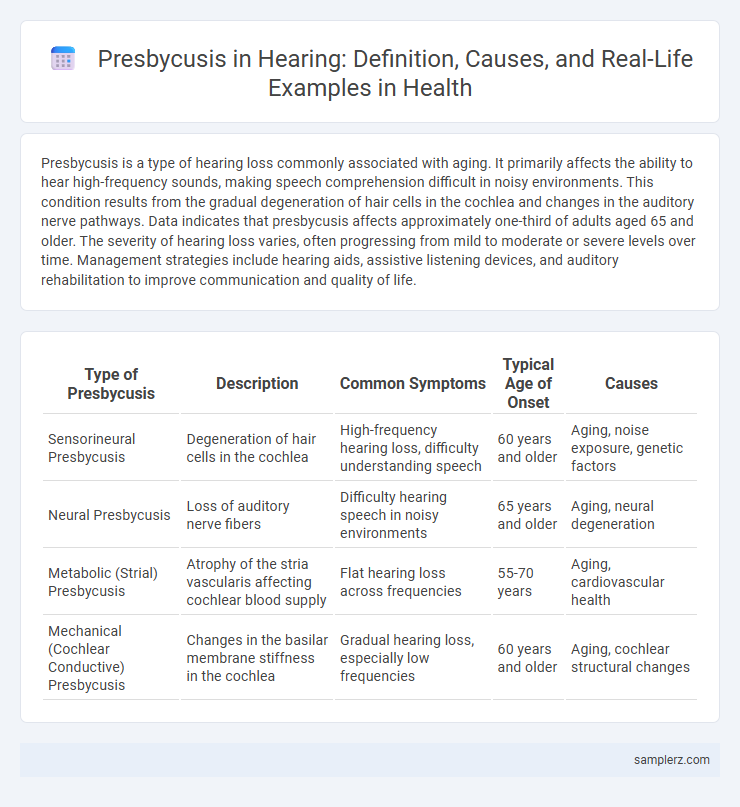Presbycusis is a type of hearing loss commonly associated with aging. It primarily affects the ability to hear high-frequency sounds, making speech comprehension difficult in noisy environments. This condition results from the gradual degeneration of hair cells in the cochlea and changes in the auditory nerve pathways. Data indicates that presbycusis affects approximately one-third of adults aged 65 and older. The severity of hearing loss varies, often progressing from mild to moderate or severe levels over time. Management strategies include hearing aids, assistive listening devices, and auditory rehabilitation to improve communication and quality of life.
Table of Comparison
| Type of Presbycusis | Description | Common Symptoms | Typical Age of Onset | Causes |
|---|---|---|---|---|
| Sensorineural Presbycusis | Degeneration of hair cells in the cochlea | High-frequency hearing loss, difficulty understanding speech | 60 years and older | Aging, noise exposure, genetic factors |
| Neural Presbycusis | Loss of auditory nerve fibers | Difficulty hearing speech in noisy environments | 65 years and older | Aging, neural degeneration |
| Metabolic (Strial) Presbycusis | Atrophy of the stria vascularis affecting cochlear blood supply | Flat hearing loss across frequencies | 55-70 years | Aging, cardiovascular health |
| Mechanical (Cochlear Conductive) Presbycusis | Changes in the basilar membrane stiffness in the cochlea | Gradual hearing loss, especially low frequencies | 60 years and older | Aging, cochlear structural changes |
Understanding Presbycusis: Definition and Overview
Presbycusis refers to age-related hearing loss that gradually reduces the ability to hear high-frequency sounds, affecting approximately one in three adults over 65. This sensorineural condition results from the degeneration of hair cells and auditory nerve pathways in the inner ear, which impairs sound processing. Common symptoms include difficulty understanding speech in noisy environments and needing increased volume levels, significantly impacting communication and quality of life.
Common Signs and Symptoms of Presbycusis
Presbycusis commonly presents with gradual, bilateral hearing loss, particularly affecting high-frequency sounds, leading to difficulty understanding speech in noisy environments. Patients often experience tinnitus and may complain of decreased sound clarity despite normal ear inspections. These symptoms typically emerge in individuals over 60 and progressively worsen, impacting communication and quality of life.
Real-Life Scenarios: How Presbycusis Manifests
Presbycusis commonly presents as difficulty understanding conversations in noisy environments, such as bustling restaurants or crowded family gatherings, where high-frequency sounds like speech consonants become less distinguishable. Older adults may frequently ask others to repeat themselves or increase the volume on televisions and radios beyond typical levels. This age-related hearing loss often affects both ears symmetrically, gradually impairing communication and social interaction over time.
Age-Related Hearing Loss: Presbycusis in Seniors
Age-related hearing loss, or presbycusis, commonly affects seniors by gradually diminishing their ability to hear high-frequency sounds, making speech comprehension challenging, especially in noisy environments. This sensorineural hearing loss results from the degeneration of hair cells in the cochlea and changes in the auditory nerve, typically becoming noticeable after age 60. Early diagnosis through audiometric testing and timely intervention with hearing aids or assistive listening devices can significantly improve communication and quality of life for older adults.
Early Indicators of Presbycusis in Everyday Life
Difficulty hearing high-frequency sounds, such as birds chirping or children's voices, often signals early presbycusis. Struggling to follow conversations in noisy environments or needing to increase the volume on televisions and phones are common indicators. These subtle hearing changes typically emerge in adults over 60, highlighting the importance of early audiometric testing for effective management.
Case Studies: Examples of Presbycusis Progression
Case studies on presbycusis reveal a gradual decline in high-frequency hearing sensitivity, typically beginning in individuals aged 60 and above. One documented progression involves initial difficulty understanding speech in noisy environments, advancing to diminished clarity even in quiet settings, impacting communication and quality of life. Audiometric evaluations consistently show bilateral sensorineural hearing loss with a characteristic sloping audiogram pattern, confirming age-related cochlear degeneration.
Impact of Presbycusis on Daily Communication
Presbycusis, or age-related hearing loss, significantly affects daily communication by reducing the ability to hear high-frequency sounds, making it difficult to understand speech, especially in noisy environments. This condition often causes older adults to miss key words or phrases, leading to frustration and social withdrawal. Impaired auditory processing in presbycusis compromises conversational engagement and can increase the risk of cognitive decline due to reduced social interaction.
Differentiating Presbycusis from Other Hearing Loss Types
Presbycusis, or age-related hearing loss, primarily affects high-frequency sounds and typically presents symmetrically in both ears, distinguishing it from noise-induced hearing loss which often shows asymmetry and a notch at 4 kHz on audiograms. Unlike conductive hearing loss caused by ear infections or obstructions, presbycusis results from degenerative changes in the cochlea or auditory nerve. Identifying these patterns through audiometric testing helps differentiate presbycusis from sensorineural losses due to ototoxicity or acoustic trauma.
Coping Strategies and Adaptations for Presbycusis
Effective coping strategies for presbycusis include using hearing aids tailored to the individual's specific hearing loss frequencies and engaging in auditory training exercises to improve speech comprehension. Environmental modifications, such as reducing background noise and ensuring clear visual cues during conversations, enhance communication. Practicing assertive communication techniques and staying socially active help mitigate the cognitive and emotional impacts of age-related hearing loss.
Seeking Medical Help: When to Consult for Presbycusis
Persistent difficulty understanding conversations in noisy environments, frequent requests for repetition, and increasing trouble hearing high-pitched sounds are common signs indicating the need to consult an audiologist for presbycusis. Early diagnosis through comprehensive hearing tests can help manage symptoms and prevent social isolation. Seeking prompt medical evaluation is crucial when everyday communication becomes challenging due to gradual hearing loss associated with aging.

example of presbycusis in hearing Infographic
 samplerz.com
samplerz.com